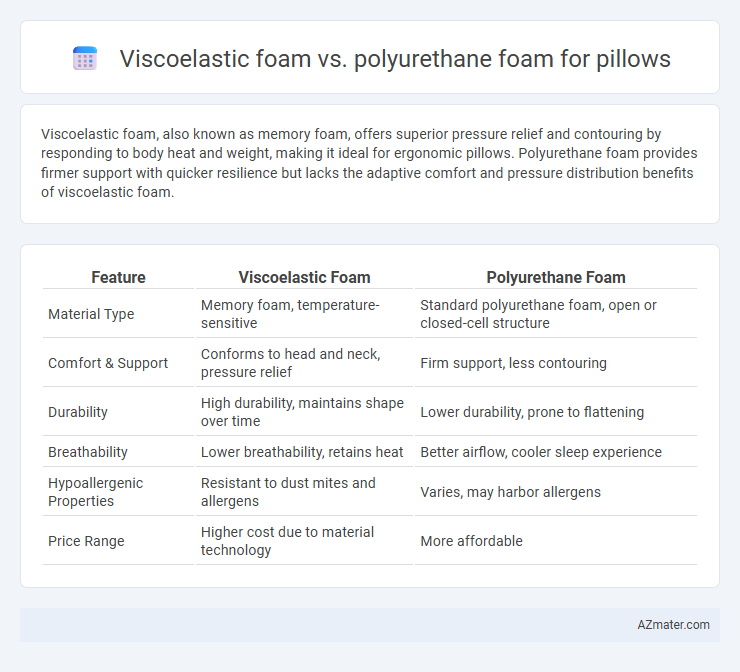Viscoelastic foam, also known as memory foam, offers superior pressure relief and contouring by responding to body heat and weight, making it ideal for ergonomic pillows. Polyurethane foam provides firmer support with quicker resilience but lacks the adaptive comfort and pressure distribution benefits of viscoelastic foam.
Table of Comparison
| Feature | Viscoelastic Foam | Polyurethane Foam |
|---|---|---|
| Material Type | Memory foam, temperature-sensitive | Standard polyurethane foam, open or closed-cell structure |
| Comfort & Support | Conforms to head and neck, pressure relief | Firm support, less contouring |
| Durability | High durability, maintains shape over time | Lower durability, prone to flattening |
| Breathability | Lower breathability, retains heat | Better airflow, cooler sleep experience |
| Hypoallergenic Properties | Resistant to dust mites and allergens | Varies, may harbor allergens |
| Price Range | Higher cost due to material technology | More affordable |
Introduction to Foam Types: Viscoelastic vs Polyurethane
Viscoelastic foam, commonly known as memory foam, is characterized by its slow response to pressure and excellent contouring properties that provide superior support and pressure relief for pillows. Polyurethane foam, often referred to as traditional foam, is more resilient and offers a firmer feel with quicker responsiveness, making it a versatile and cost-effective option. Both foam types differ significantly in density, elasticity, and breathability, affecting pillow comfort and durability.
What is Viscoelastic Foam? Key Features Explained
Viscoelastic foam, commonly known as memory foam, is a high-density polyurethane foam treated with chemicals to increase its viscosity and density, providing superior conforming properties. Key features include its ability to respond to body heat and pressure for personalized support, excellent motion isolation, and slow return to its original shape, which enhances comfort and reduces pressure points. Polyurethane foam, by contrast, offers more bounce and less contouring, making viscoelastic foam the preferred choice for ergonomic pillows designed to improve spinal alignment and sleep quality.
Understanding Polyurethane Foam in Pillows
Polyurethane foam in pillows offers a versatile and affordable cushioning material known for its lightweight and durability. Unlike viscoelastic foam, polyurethane foam provides consistent support without contouring closely to the head and neck, making it suitable for sleepers who prefer a more traditional, resilient feel. Its open-cell structure promotes breathability and quick moisture evaporation, enhancing overall pillow comfort and hygiene.
Comfort Comparison: Viscoelastic vs Polyurethane
Viscoelastic foam, also known as memory foam, offers superior contouring and pressure relief by molding precisely to the shape of the head and neck, enhancing overall comfort during sleep. Polyurethane foam, while generally firmer and less adaptive, provides consistent support but may not conform as effectively, potentially leading to pressure points. The viscoelastic foam's ability to absorb motion and reduce tossing makes it a preferred choice for those seeking enhanced comfort and spinal alignment in pillows.
Support and Pressure Relief Differences
Viscoelastic foam, commonly known as memory foam, offers superior support by contouring closely to the body and evenly distributing weight, significantly reducing pressure points compared to traditional polyurethane foam. Polyurethane foam provides a firmer and more resilient structure, offering less contouring but quicker responsiveness and support suitable for those who prefer a more buoyant pillow feel. The viscoelastic foam excels in pressure relief by adapting to the sleeper's shape and maintaining spinal alignment, while polyurethane foam may not conform as precisely, potentially leading to uneven support and pressure accumulation.
Temperature Regulation and Breathability
Viscoelastic foam, also known as memory foam, offers superior temperature regulation through its heat-sensitive properties that contour to the body but can retain heat, potentially reducing breathability. Polyurethane foam, in contrast, generally provides better airflow and breathability due to its open-cell structure, promoting cooler sleeping conditions. For optimal pillow comfort, viscoelastic foam with infused cooling gels or ventilation holes can improve temperature regulation while maintaining its contouring benefits.
Durability and Longevity: Which Foam Lasts Longer?
Viscoelastic foam, also known as memory foam, typically offers greater durability and longevity compared to standard polyurethane foam due to its dense structure and resistance to sagging over time. Polyurethane foam tends to compress and break down faster, especially under continuous use, leading to reduced support and comfort after extended periods. For pillows, viscoelastic foam often maintains its shape and cushioning properties significantly longer, making it a preferred choice for long-term durability.
Allergy and Health Considerations
Viscoelastic foam, often known as memory foam, exhibits hypoallergenic properties by resisting dust mites and mold, making it suitable for allergy-sensitive individuals. Polyurethane foam, while versatile and cost-effective, may emit volatile organic compounds (VOCs) that can exacerbate respiratory issues and cause skin irritation in sensitive users. Choosing viscoelastic foam pillows can reduce allergen exposure and promote better respiratory health due to their dense, non-porous structure that limits allergen accumulation.
Price Differences and Value for Money
Viscoelastic foam pillows typically cost more due to their superior pressure-relieving properties and durability compared to standard polyurethane foam. While polyurethane foam pillows are more affordable upfront, their shorter lifespan and lower support quality may lead to faster replacement costs, reducing overall value for money. Investing in viscoelastic foam provides enhanced comfort and longevity, often justifying the higher price through improved sleep quality and extended pillow durability.
How to Choose the Right Foam Pillow for You
Viscoelastic foam, known as memory foam, contours to your head and neck, offering superior pressure relief and support, ideal for side and back sleepers seeking comfort and spinal alignment. Polyurethane foam is lighter and more affordable, providing variable firmness levels that suit stomach sleepers or those preferring a bouncier, less conforming pillow. To choose the right foam pillow, assess your sleep position, preferred firmness, and sensitivity to materials, considering factors like durability, breathability, and allergen resistance.

Infographic: Viscoelastic foam vs Polyurethane foam for Pillow
 azmater.com
azmater.com